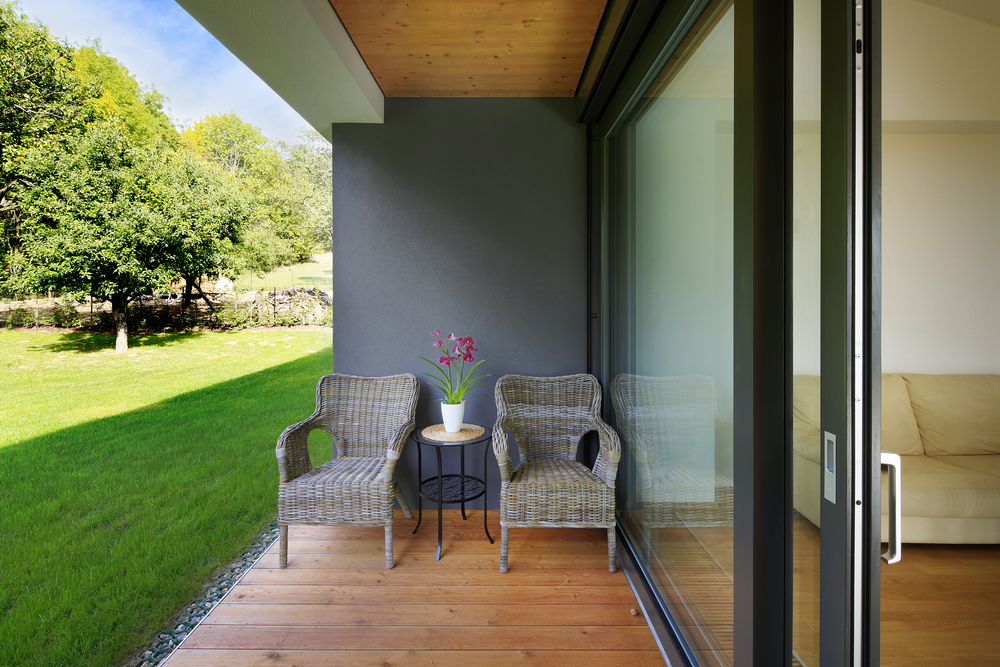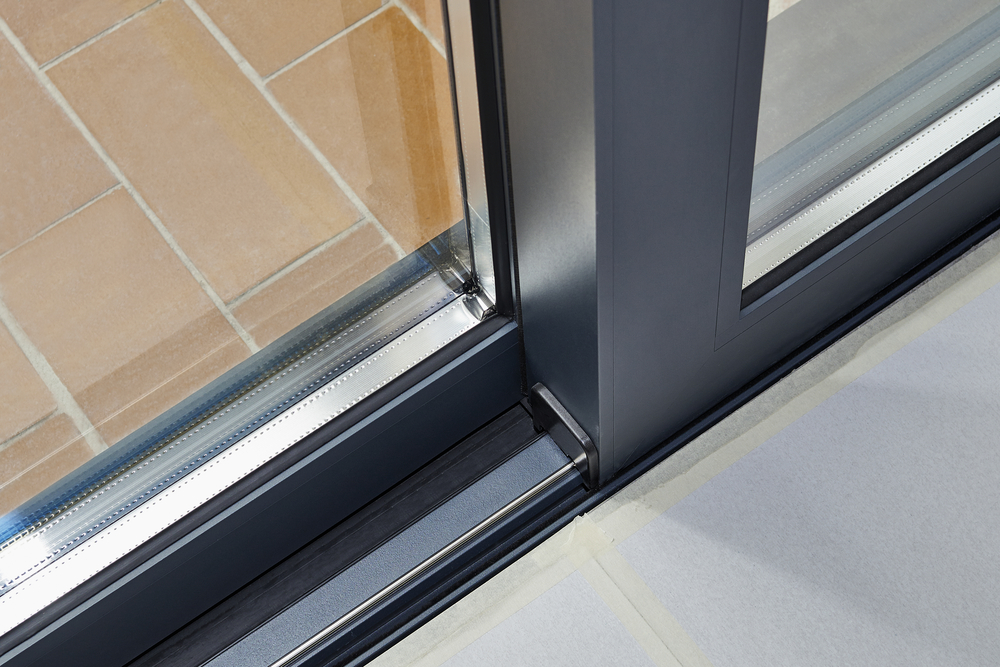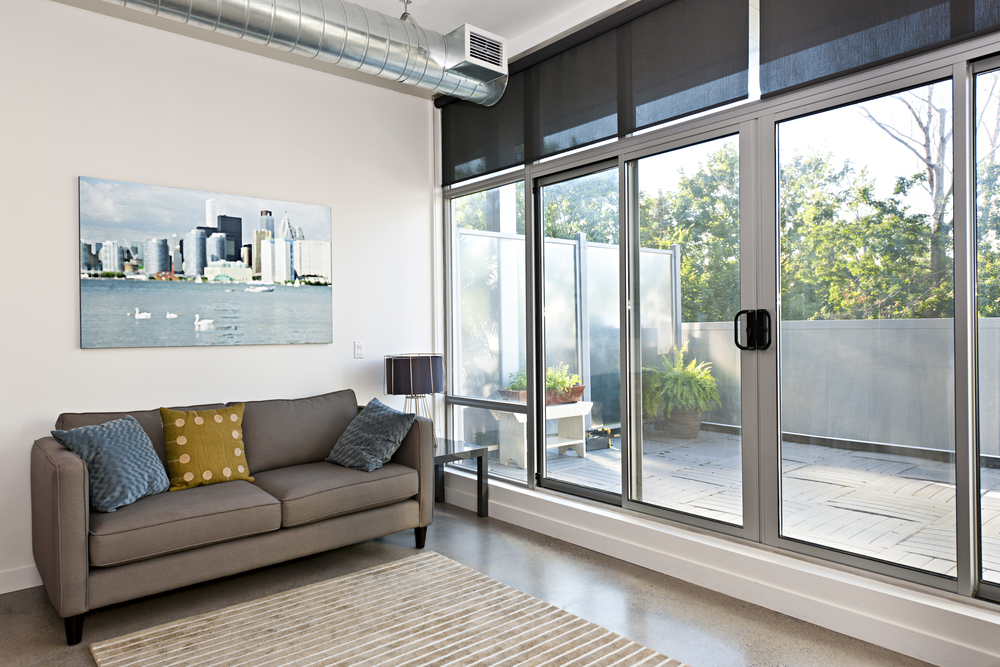We may earn revenue from the products available on this page and participate in affiliate programs. Learn More ›
If you’re lucky enough to have a sliding glass door in your living space, you’ve probably marveled at the amount of light that floods your home. Sliding doors bring the outdoors in, offering portals for sunshine, beautiful views of leafy scenery, contemplative snowy vistas, or a cheerful view of kids playing in the yard. When open, nothing compares to the fresh air that a sliding door allows to breeze through your home. Sliding doors really have only two significant drawbacks: they’re a bear to keep clean, especially if you have pets or children, and more importantly, they can be a significant security risk. These doors that let you see outside can also let would-be thieves or intruders see in, and if not properly secured, may give them easy access to your home. So how can you best secure a sliding glass door?
Before You Begin…
Securing your sliding glass doors can involve several steps. Before you get started, take a critical look at your door. Is the framing surrounding the door sturdy and strong enough to provide a solid foundation for locking mechanisms? Do both panels of your door slide, or is one fixed?

Sliding doors run on tracks, which means that securing them isn’t as simple as installing a new deadbolt and a sturdy hinge. Tracks provide more leverage points for handy burglars to use to their advantage and can make it tricky to fully secure the doors. Your first order of business will be to secure the door as firmly as possible using a combination of locking options.
The expanse of uninterrupted glass is also a security concern on several levels. While you can feel reasonably secure behind a solid steel or wood door with a good deadbolt, a glass pane offers an easy workaround: An intruder could simply smash the glass to gain access. In addition, large windows allow for a more unobstructed view of valuable possessions. Peer through the door from the outside. What can you see? Would a curtain or blinds obscure some of the view? What about shifting the furniture around—or simply tucking away some belongings that look like an easy grab? Take the simple, free steps first before moving to larger solutions. Covering a slider all the time defeats the purpose of having one, so you’ll have to strike a balance between securing your home and letting the light in, and you may need to enhance your security in other ways.
STEP 1: Apply a shatterproof window film to the sliding glass door.
This is an easy, inexpensive option that provides two layers of security. Adhesive security film is available in precut sizes or rolls that you can trim yourself. When applied correctly, it can be invisible. The thin vinyl will bond with the glass, making it extremely difficult to break—and if the glass cracks, the vinyl will prevent it from shattering out of the frame, continuing to provide an obstacle for anyone trying to gain entry to your home. The film is removable and replaceable. Clear film will allow a full, clear view out of your home, almost as if there’s nothing there but glass—but it also allows a full view into the home, so if you’re not planning to install curtains, blinds, or other window treatments that will allow you to close off the door when necessary, you can consider some of the alternatives.
Need a home security system? SimpliSafe can help. With a comprehensive whole-house solution, you can be prepared for the unexpected. View SimpliSafe systems and prices.

Mirrored films let in light and allow one-way viewing, though it’s important to remember that mirrored film will allow the side with the brightest backlight to be seen. During the day, when it’s sunny outside, you’ll have a clear view out through your window, and anyone looking in will see a reflective surface. At night, however, you’ll have the lights on, so you’ll see a mirrored surface from inside and anyone looking from the outside will have a clear view of you and your home.
Frosted films provide the greatest degree of security. These films can be smooth-frosted, with just a hazy finish, or patterned. They are translucent enough to let in light, but they block the view through the doors. If you like your view, these won’t be practical; it would make just as much sense to replace the sliders with wood or steel doors or a wall and windows. If, however, security trumps the view in your situation, frosted films can provide peace of mind and still keep your space brighter.
If you’re investing in new doors, you can choose reinforced glass, which has a non-shattering layer impregnated into the glass already. You may find that you still want more privacy and choose to add a frosted layer, but the glass itself will be more secure from breakage.
STEP 2: Add a rod or a deadbolt lock.
Once you’ve protected the glass, you’ll need to prevent the door from being jimmied. Tracks offer a great place for a burglar to use a crowbar to pry the door off its track or pop a weak deadbolt and slide the door open. Securing the door will take several steps. First, you’ll want to choose from several types of sliding glass door locks, making sure that the bolt that locks the door closed is strong enough to withstand some force. The tiny flip locks that most doors are supplied with during manufacturing aren’t sufficient; in fact, some are so flimsy that they can be popped open with a credit card. Adding an aftermarket deadbolt will make your door stronger and easier to secure. These bolts can drive into the side of the sash or into the floor or ceiling mid-track. Some even provide an option to bolt the door open a few inches, similar to a night lock on a window, by featuring an additional strike plate that is placed a few inches from the closed position to secure the bolt. If your door is a regular entry point for your home, you can choose a sliding door lock with keys to make the door more functional.
Frontpoint protects your home in an emergency, whether it’s a break-in, fire, medical emergency, and more. View Frontpoint products.

Adding an extra lock for doors that don’t arrive well equipped from the factory is a good first step, but the potential for a criminal to force the door open on its tracks is still present. Overnight, and anytime you prefer extra security, you’ll want to block the space where the door would slide open if forced. This can be accomplished by fitting a rod or large dowel into the tracks between the door that moves on the tracks and the doorframe. This simple step physically prevents the door from being opened.
For the highest level of security, the rod should extend from the edge of the door all the way to the frame and fit snugly, so there’s very little wiggle room if someone should manage to pop open the lock. Some homeowners choose to keep rods in a few lengths so that they can open the door a few inches for air but prevent it from opening any farther. This is a great option during the day, but when you’re asleep or not at home, the door will be at its most secure with a lock fastened and the rod in place.
If a loose rod seems like an inconvenience, you can choose to purchase a sliding door lock bar, which is a two-part mechanism. The adjustable metal bar attaches to the doorframe with hardware, and a receiver bracket is screwed into the edge of the functional door. The homeowner simply extends the bar and lowers it into the receiver bracket, which then prevents the door from being opened or the bar from being popped free. This option is more visible than a rod dropped into the track, which provides a visual deterrent to anyone interested in breaking in, but some homeowners may find it unsightly.
STEP 3: Invest in a home security system with cameras, alarms, sensors, monitoring, and more.
You’ve created the option to obscure the view into your home, reinforced the glass, and installed a sliding door lock, possibly a sliding glass door lock with key. What’s left? The fact is that no matter how many security features you add to a sliding door, it will never be quite as secure as a solid core door with a standard door security lock. So your best option may be to add more eyes to keep an eye on potential threats to the entryway.
A home security system, whether self-monitored with an app and a smartphone or professionally monitored by a home security company, can bolster the physical security you’ve already added to your door. Cameras will provide a warning that someone is loitering in proximity to your home, and they potentially may ward off would-be intruders by letting them know that someone is watching. If a break-in does occur, cameras may help identify the intruder and help you reclaim stolen items.
Security systems offer glass-break sensors and door-opening sensors, as well as cameras, so you can be alerted to someone trying to get into your home should they manage to bypass your patio door lock. If you’re home, this notification can give you time to exit the home from another location or secure your family in a safe room in the home; it’s best not to confront someone trying to break in. These sensors can also be programmed to trigger loud alarms that should scare off an intruder. Alarms are particularly important if you have opted not to install glass security film; the loud alarm may convince a burglar who has smashed the glass to run immediately without taking anything once they’ve broken the glass on the door.
Your patio door or sliding glass door can make your space feel larger and your day feel brighter, and with some carefully chosen security components, it can be a secure part of your home’s envelope. The best way to secure the door and enjoy the light and views it provides is with a layered approach: Strengthen the glass, strengthen the lock, and increase the monitoring of the area beyond your own eyes. Then you can relax in your bright room with peace of mind.


